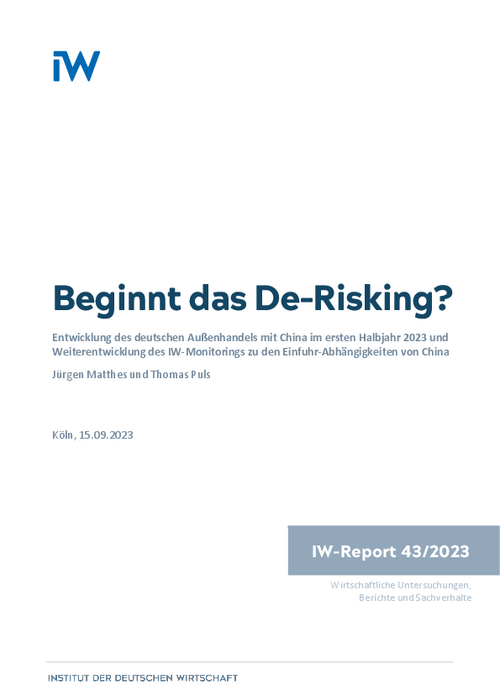An analysis of German foreign trade with China and import dependencies on China in the first half of 2023 shows: Compared to the first half of 2022, German exports to China fell by over 8 percent and German imports from China by almost 17 percent.

Is the derisking beginning?

An analysis of German foreign trade with China and import dependencies on China in the first half of 2023 shows: Compared to the first half of 2022, German exports to China fell by over 8 percent and German imports from China by almost 17 percent.
A deeper analysis reveals that developments in only a few sectors were decisive for this: On the import side, these include above all a negative special development in the chemicals sector. This effect alone accounts for 14 percentage points of the total import decline of 17 percent. On the other hand, there was a significant increase in imports of electrical equipment by 25 percent and of motor vehicles and parts by 75 percent compared to the previous half-year. These two effects add up to a positive import growth contribution of almost 5 percentage points. The development of automotive trade also led to remarkable effects on the export side: The 21 percent decline in exports of motor vehicles and parts accounts for three quarters of the total export decline of over 8 percent.
Particularly, in the trade in motor vehicles and engines striking changes have occurred. These have various causes. On the one hand, several Chinese vehicle manufacturers entered the German market around the turn of the year, causing their sales figures to rise sharply from a low base and thus also the value of imports from China. On the other hand, the business model that used to support car production in Germany - the intercontinental export of high-quality vehicles - is coming under increasing pressure. German manufacturers have been relocating more and more production to China for years, currently also increasingly in the previously resistant premium class. The reason for this is above all China's outstanding importance as a sales market, but also the energy transition and the planned phasing out of the combustion engine. In addition, China has economies of scope in the production of electrified powertrains. Overall, there are strong arguments for the production of additional models in China. In the future, as also the export model of premium cars is beginning to falter with increasing trends to a ‘local for local’ strategy, the development of the German car industry worldwide is likely to contribute less to the development of the German car industry in Germany.
The continuation and deepening of the IW monitoring of import dependencies on China shows that, at best, the first signs of import-side derisking are emerging: Among more than 800 eight-digit product groups with a Chinese import share of more than 50 percent in 2022 and a relatively high import value, there were significantly more share declines in the first half of 2023 than in 2022, with around 70 percent of the groups. A closer look, however, puts this result into perspective. At just under 16 percent, the share of product groups with significant declines of more than 20 percentage points in the Chinese import share in 2023 is only limited. The attempt to narrow down critical dependencies also puts things into perspective. Thus, strong share reductions are less relevant if the view is narrowed to product groups with high import values and/or with a tendency to focus on industry. Among the industry-focused product groups with an import value of more than 5 million euros in the first half of 2023, the share of Chinese import share reductions is only slightly more than half and the share of strong reductions of more than 20 percentage points is only less than five percent. It therefore seems premature to draw a clear conclusion about the extent of possible derisking. A closer look at industry-focused product groups shows in which areas particularly sensitive dependencies lie.
In order to measure derisking - understood as a reduction of really critical import dependencies - even more precise dependency monitoring is needed. This requires expert interviews and even more in-depth foreign trade foreign trade analyses. It is the task of the German government to make such elaborate research possible on a regular basis and thus to fill the China strategy with life with regard to the derisking goal.

Is the derisking beginning?

More on the topic

A Macroeconomic Analysis of Wage-Price Spirals
The subject of this Analysis is the forms that wage-price spirals can take and how they influence macroeconomic stability and inflationary trends in Germany.
IW
Pharmaceutical industry: Increasing pressure on the labor market
The shortage of skilled workers poses significant challenges for pharmaceutical companies in Germany and is expected to become increasingly problematic in the context of demographic changes. Concerning Germany's positioning in the international competition ...
IW